-
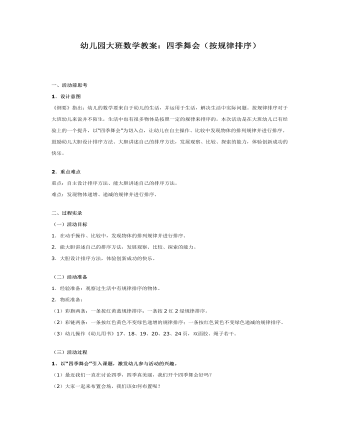
幼儿园大班数学教案:四季舞会
2.重点难点 重点:自主设计排序方法、能大胆讲述自己的排序方法。 难点:发现物体递增、递减的规律并进行排序。 二、过程实录 (一)活动目标 1.在动手操作、比较中,发现物体的排列规律并进行排序。 2.能大胆讲述自己的排序方法,发展观察、比较、探索的能力。 3.大胆设计排序方法,体验创新成功的快乐。 (二)活动准备 1.经验准备:观察过生活中有规律排序的物体。 2.物质准备: (1)彩旗两条:一条按红黄蓝规律排序;一条按2红2绿规律排序。 (2)彩链两条:一条按红色黄色不变绿色递增的规律排序;一条按红色黄色不变绿色递减的规律排序。 (3)幼儿操作《幼儿用书》17、18、19、20、23、24页,双面胶、绳子若干。
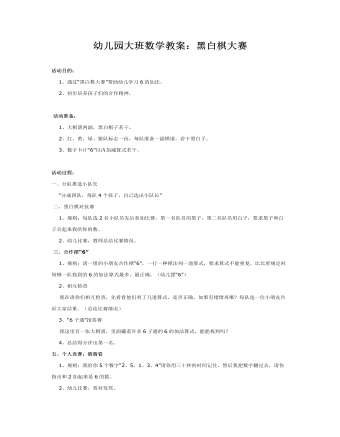
幼儿园大班数学教案:黑白棋大赛
活动准备: 1、大棋谱两副,黑白棋子若干。 2、红、黄、绿、紫队标志一份,每队准备一副棋谱,若干黑白子。 3、数字卡片“6”以内加减算式若干。 活动过程: 一、分队推选小队长 “分成四队,每队4个孩子,自己选出小队长” 二、黑白棋对抗赛 1、规则:每队选2名小队员先后参加比赛,第一名队员用黑子,第二名队员用白子,要求黑子和白子合起来我给你的数。 2、幼儿比赛,教师总结比赛情况。
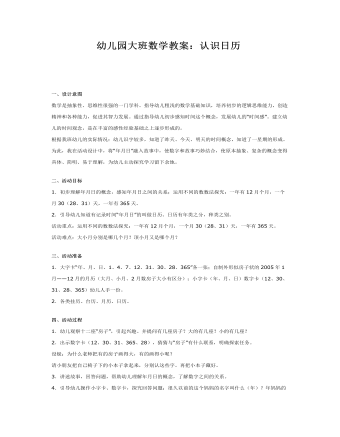
幼儿园大班数学教案:认识日历
二、活动目标1.初步理解年月日的概念,感知年月日之间的关系;运用不同的数数法探究:一年有12月个月,一个月30(28、31)天,一年有365天。 2.引导幼儿知道有记录时间“年月日”的叫做日历。日历有年类之分,种类之别。 活动重点:运用不同的数数法探究:一年有12月个月,一个月30(28、31)天,一年有365天。 活动难点:大小月分别是哪几个月?顶小月又是哪个月?三、活动准备 1.大字卡“年、月、日、1、4、7、12、31、30、28、365”各一张;自制外形似房子状的2005年1月——12月的月历(大月、小月、2月数房子大小有区分);小字卡(年、月、日)数字卡(12、30、31、28、365)幼儿人手一份。 2.各类挂历、台历、月历、日历。
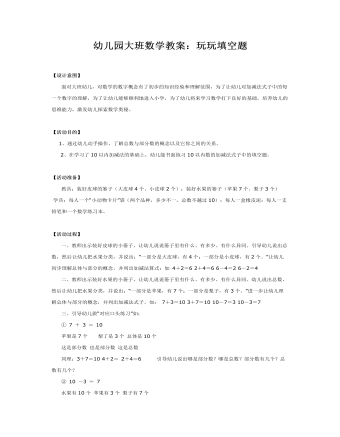
幼儿园大班数学教案:玩玩填空题
【活动目的】 1、通过幼儿动手操作,了解总数与部分数的概念以及它你之间的关系。 2、在学习了10以内加减法的基础上,幼儿能书面练习10以内数的加减法式子中的填空题。 【活动准备】 教具:装好皮球的篓子(大皮球4个、小皮球2个);装好水果的篓子(苹果7个、梨子3个) 学具:每人一个“小动物卡片”袋(两个品种,多少不一,总数不越过10);每人一盒橡皮泥;每人一支铅笔和一个数学练习本。
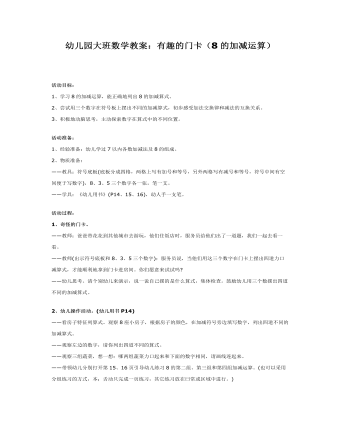
幼儿园大班数学教案:有趣的门卡
活动准备: 1、经验准备:幼儿学过7以内各数加减法及8的组成。 2、物质准备: ——教具:符号底板(底板分成四格,两格上写有加号和等号,另外两格写有减号和等号,符号中间有空间便于写数字),8、3、5三个数字各一张,笔一支。 ——学具:《幼儿用书》(P14、15、16),幼人手一支笔。活动过程: 1、奇怪的门卡。 ——教师:爸爸带花花到其他城市去游玩,他们住饭店时,服务员给他们出了一道题,我们一起去看一看。 ——教师(出示符号底板和8、3、5三个数字):服务员说,当他们用这三个数字在门卡上摆出四道力口减算式,才能顺利地拿到门卡进房间。你们愿意来试试吗? ——幼儿思考。请个别幼儿来演示,说一说自己摆的是什么算式,集体检查。鼓励幼儿用三个数摆出四道不同的加减算式。
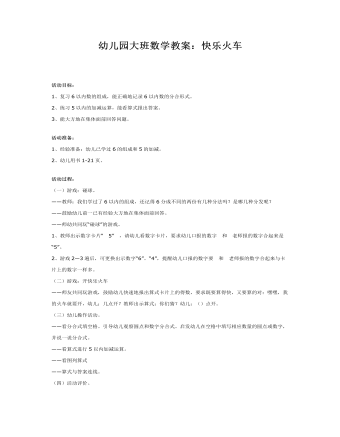
幼儿园大班数学教案:快乐火车
2、练习5以内的加减运算,能看算式报出答案。 3、能大方地在集体面前回答问题。活动准备: 1、经验准备:幼儿已学过6的组成和5的加减。 2、幼儿用书1-21页。活动过程: (一)游戏:碰球。 ——教师:我们学过了6以内的组成,还记得6分成不同的两份有几种分法吗?是哪几种分发呢? ——鼓励幼儿前一已有经验大方地在集体面前回答。 ——师幼共同玩“碰球”的游戏。 1、教师出示数字卡片“5” ,请幼儿看数字卡片,要求幼儿口报的数字 和 老师报的数字合起来是“5”。
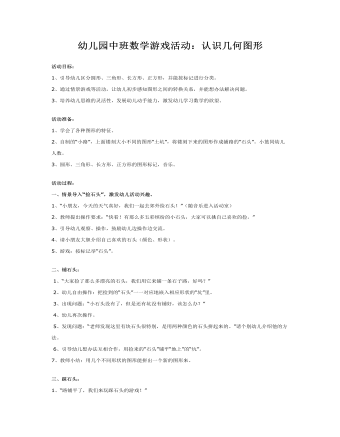
中班数学教案:认识几何图形
2、通过情景游戏等活动,让幼儿初步感知图形之间的转换关系,并能想办法解决问题。 3、培养幼儿思维的灵活性,发展幼儿动手能力,激发幼儿学习数学的欲望。活动准备: 1、学会了各种图形的特征。 2、自制的“小路”,上面镂刻大小不同的图形“土坑”,将镂刻下来的图形作成铺路的“石头”。小篮同幼儿人数。 3、圆形、三角形、长方形、正方形的图形标记,音乐。 活动过程: 一、情景导入“捡石头”,激发幼儿活动兴趣。 1、“小朋友,今天的天气真好,我们一起去郊外捡石头!”(随音乐进入活动室) 2、教师提出操作要求:“快看!有那么多五彩缤纷的小石头,大家可以挑自己喜欢的捡。”
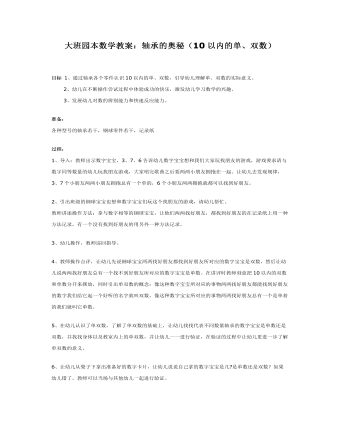
大班园本数学教案:轴承的奥秘
3、发展幼儿对数的辨别能力和快速反应能力。 准备: 各种型号的轴承若干,钢球零件若干,记录纸 过程: 1、导入:教师出示数字宝宝,3、7、6告诉幼儿数字宝宝想和我们大家玩找朋友的游戏,游戏要求请与数字同等数量的幼儿玩找朋友游戏,大家唱完歌曲之后要两两小朋友拥抱在一起。让幼儿去发现规律,3、7个小朋友两两小朋友拥抱总有一个单的,6个小朋友两两拥抱就都可以找到好朋友。 2、引出班级的钢球宝宝也想和数字宝宝们玩这个找朋友的游戏,请幼儿帮忙。 教师讲述操作方法:拿与数字相等的钢球宝宝,让他们两两找好朋友,都找到好朋友的在记录纸上用一种方法记录,有一个没有找到好朋友的用另外一种方法记录。
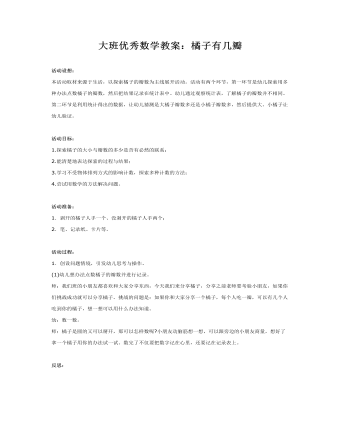
大班优秀数学教案:橘子有几瓣
活动目标:1.探索橘子的大小与瓣数的多少是否有必然的联系;2.能清楚地表达探索的过程与结果;3.学习不受物体排列方式的影响计数,探索多种计数的方法;4.尝试用数学的方法解决问题。 活动准备:1.剥开的橘子人手一个、没剥开的橘子人手两个;2.笔、记录纸、卡片等。 活动过程:1.创设问题情境,引发幼儿思考与操作。(1)幼儿想办法点数橘子的瓣数并进行记录。师:我们班的小朋友都喜欢和大家分享东西,今天我们来分享橘子,分享之前老师要考验小朋友,如果你们挑战成功就可以分享橘子。挑战的问题是:如果你和大家分享一个橘子,每个人吃一瓣,可以有几个人吃到你的橘子,想一想可以用什么办法知道。幼:数一数。师:橘子是圆的又可以掰开,那可以怎样数呢?小朋友动脑筋想一想,可以跟旁边的小朋友商量,想好了拿一个橘子用你的办法试一试。数完了不仅要把数字记在心里,还要记在记录表上。

新人教版高中英语选修2Unit 4 Journey Across a Vast Land教学设计
当孩子们由父母陪同时,他们才被允许进入这个运动场。3.过去分词(短语)作状语时的几种特殊情况(1)过去分词(短语)在句中作时间、条件、原因、让步状语时,相当于对应的时间、条件、原因及让步状语从句。Seen from the top of the mountain (=When it is seen from the top of the mountain), the whole town looks more beautiful.从山顶上看,整个城市看起来更美了。Given ten more minutes (=If we are given ten more minutes), we will finish the work perfectly.如果多给十分钟,我们会完美地完成这项工作。Greatly touched by his words (=Because she was greatly touched by his words), she was full of tears.由于被他的话深深地感动,她满眼泪花。Warned of the storm (=Though they were warned of the storm), the farmers were still working on the farm.尽管被警告了风暴的到来,但农民们仍在农场干活。(2)过去分词(短语)在句中作伴随、方式等状语时,可改为句子的并列谓语或改为并列分句。The teacher came into the room, followed by two students (=and was followed by two students).后面跟着两个学生,老师走进了房间。He spent the whole afternoon, accompanied by his mom(=and was accompanied by his mom).他由母亲陪着度过了一整个下午。

新人教版高中英语选修2Unit 1 Science and Scientists-Learning about Language教学设计
Step 7: complete the discourse according to the grammar rules.Cholera used to be one of the most 1.__________ (fear) diseases in the world. In the early 19th century, _2_________ an outbreak of cholera hit Europe, millions of people died. But neither its cause, 3__________ its cure was understood. A British doctor, John Snow, wanted to solve the problem and he knew that cholera would not be controlled _4_________ its cause was found. In general, there were two contradictory theories 5 __________ explained how cholera spread. The first suggested that bad air caused the disease. The second was that cholera was caused by an _6_________(infect) from germs in food or water. John Snow thought that the second theory was correct but he needed proof. So when another outbreak of cholera hit London in 1854, he began to investigate. Later, with all the evidence he _7_________ (gather), John Snow was able to announce that the pump water carried cholera germs. Therefore, he had the handle of the pump _8_________ (remove) so that it couldn't be used. Through his intervention,the disease was stopped in its tracks. What is more, John Snow found that some companies sold water from the River Thames that __9__________________ (pollute) by raw waste. The people who drank this water were much more likely _10_________ (get) cholera than those who drank pure or boiled water. Through John Snow's efforts, the _11_________ (threaten) of cholera around the world saw a substantial increase. Keys: 1.feared 2.when 3. nor 4.unless 5.that/which 6.infection 7.had gathered 8.removed 9.was polluted 10.to get 11. threat

新人教版高中英语选修2Unit 1 Science and Scientists-Reading and thinking教学设计
Step 5: After learning the text, discuss with your peers about the following questions:1.John Snow believed Idea 2 was right. How did he finally prove it?2. Do you think John Snow would have solved this problem without the map?3. Cholera is a 19th century disease. What disease do you think is similar to cholera today?SARS and Covid-19 because they are both deadly and fatally infectious, have an unknown cause and need serious public health care to solve them urgently.keys:1. John Snow finally proved his idea because he found an outbreak that was clearly related to cholera, collected information and was able to tie cases outside the area to the polluted water.2. No. The map helped John Snow organize his ideas. He was able to identify those households that had had many deaths and check their water-drinking habits. He identified those houses that had had no deaths and surveyed their drinking habits. The evidence clearly pointed to the polluted water being the cause.3. SARS and Covid-19 because they are both deadly and fatally infectious, have an unknown cause and need serious public health care to solve them urgently.Step 6: Consolidate what you have learned by filling in the blanks:John Snow was a well-known _1___ in London in the _2__ century. He wanted to find the _3_____ of cholera in order to help people ___4_____ it. In 1854 when a cholera __5__ London, he began to gather information. He ___6__ on a map ___7___ all the dead people had lived and he found that many people who had ___8____ (drink) the dirty water from the __9____ died. So he decided that the polluted water ___10____ cholera. He suggested that the ___11__ of all water supplies should be _12______ and new methods of dealing with ____13___ water be found. Finally, “King Cholera” was __14_____.Keys: 1. doctor 2. 19th 3.cause 4.infected with 5.hit 6.marked 7.where 8.drunk 9.pump 10.carried 11.source 12.examined 13.polluted 14.defeatedHomework: Retell the text after class and preview its language points

新人教版高中英语选修2Unit 2 Bridging Cultures-Discovering useful structures教学设计
The grammar of this unit is designed to review noun clauses. Sentences that use nouns in a sentence are called noun clauses. Nominal clauses can act as subject, object, predicate, appositive and other components in compound sentences. According to the above-mentioned different grammatical functions, nominal clauses are divided into subject clause, object clause, predicate clause and appositive clause. In this unit, we will review the three kinds of nominal clauses. Appositive clauses are not required to be mastered in the optional compulsory stage, so they are not involved.1. Guide the students to judge the compound sentences and determine the composition of the clauses in the sentence.2. Instruct students to try to learn grammar by generalizing grammar rules, controlling written practice, and semi-open oral output.3. Inspire the students to systematize the function and usage of noun clause1.Instruct students to try to learn grammar by generalizing grammar rules, controlling written practice, and semi-open oral output.2.Inspire the students to systematize the function and usage of noun clauseStep1: The teacher ask studetns to find out more nominal clauses from the reading passage and udnerline the nominal clauses.

新人教版高中英语选修2Unit 5 First Aid-Discovering useful structures教学设计
You have no excuse for not going.你没有理由不去。He was punished for not having finished his homework.他因未完成作业而受到惩罚。2.动词ing形式复合结构由物主代词或人称代词宾格、名词所有格或普通格加动词ing,即“sb./sb.'s+doing”构成。动词ing形式的复合结构实际上是给动词ing形式加了一个逻辑主语。动词ing形式的复合结构有四种形式:①形容词性物主代词+动词ing②名词所有格+动词ing③代词宾格+动词ing④名词+动词ingHer coming to help encouraged all of us.她来帮忙鼓舞了我们所有人。The baby was made awake by the door suddenly shutting.这个婴儿被突然的关门声吵醒了。Can you imagine him/Jack cooking at home?你能想象他/杰克在家做饭的样子吗?无生命名词无论是作主语还是作宾语都不能用第②种形式。Tom's winning first prize last year impressed me a lot.汤姆去年得了一等奖使我印象深刻。Do you mind my/me/Jack's/Jack leaving now?你介意我/杰克现在离开吗?Excuse me for my not coming on time.很抱歉我没能按时来。His father's being ill made him worried.他父亲病了,他很担心。We are looking forward to the singer's/the singer to give us a concert.我们盼望着这位歌手来给我们举办一场演唱会。

新人教版高中英语选修2Unit 1 Science and Scientists-Discovering useful structures教学设计
The grammatical structure of this unit is predicative clause. Like object clause and subject clause, predicative clause is one of Nominal Clauses. The leading words of predicative clauses are that, what, how, what, where, as if, because, etc.The design of teaching activities aims to guide students to perceive the structural features of predicative clauses and think about their ideographic functions. Beyond that, students should be guided to use this grammar in the context apporpriately and flexibly.1. Enable the Ss to master the usage of the predicative clauses in this unit.2. Enable the Ss to use the predicative patterns flexibly.3. Train the Ss to apply some skills by doing the relevant exercises.1.Guide students to perceive the structural features of predicative clauses and think about their ideographic functions.2.Strengthen students' ability of using predicative clauses in context, but also cultivate their ability of text analysis and logical reasoning competence.Step1: Underline all the examples in the reading passage, where noun clauses are used as the predicative. Then state their meaning and functions.1) One theory was that bad air caused the disease.2) Another theory was that cholera was caused by an infection from germs in food or water.3) The truth was that the water from the Broad Street had been infected by waste.Sum up the rules of grammar:1. 以上黑体部分在句中作表语。2. 句1、2、3中的that在从句中不作成分,只起连接作用。 Step2: Review the basic components of predicative clauses1.Definition

新人教版高中英语选修2Unit 1 Science and Scientists-Using langauge教学设计
This happens because the dish soap molecules have a strong negative charge, and the milk molecules have a strong positive charge. Like magnets, these molecules are attracted to each other, and so they appear to move around on the plate, taking the food coloring with them, making it look like the colors are quickly moving to escape from the soap.Listening text:? Judy: Oh, I'm so sorry that you were ill and couldn't come with us on our field trip. How are you feeling now? Better?? Bill: Much better, thanks. But how was it?? Judy: Wonderful! I especially liked an area of the museum called Light Games.it was really cool. They had a hall of mirrors where I could see myself reflected thousands of times!? Bill: A hall of mirrors can be a lot of fun. What else did they have?? Judy: Well, they had an experiment where we looked at a blue screen for a while, and then suddenly we could see tiny bright lights moving around on it. You'll never guess what those bright lights were!? Bill: Come on, tell me!? Judy: They were our own blood cells. For some reason, our eyes play tricks on us when we look at a blue screen, and we can see our own blood cells moving around like little lights! But there was another thing I liked better. I stood in front of a white light, and it cast different shadows of me in every color of the rainbow!? Bill: Oh, I wish I had been there. Tell me more!? Judy: Well, they had another area for sound. They had a giant piano keyboard that you could use your feet to play. But then, instead of playing the sounds of a piano, it played the voices of classical singers! Then they had a giant dish, and when you spoke into it, it reflected the sound back and made it louder. You could use it to speak in a whisper to someone 17 meters away.? Bill: It all sounds so cool. I wish I could have gone with you? Judy: I know, but we can go together this weekend. I'd love to go there again!? Bill: That sounds like a great idea!
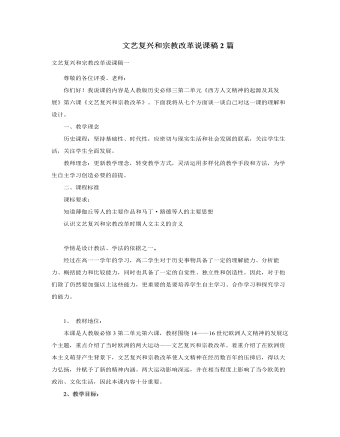
人教版高中历史必修3文艺复兴和宗教改革说课稿2篇
师:在科学发展过程中,前一个理论体系的不完善之处,往往是新的研究和新的发现的突破口。开普勒之后,意大利天文学家伽利略创制了天文望远镜,用更加精确的观察继续发展和验证哥白尼创立的新天文学理论。除了用望远镜进行天文观察以外,伽利略还开始进行自然科学的实验研究,哪位同学能给大家讲一讲伽利略在比萨斜塔上所作的关于物体自由下落的实验?生:(讲述这一实验)师:所以,伽利略在科学方面更加重要的贡献是奠定了近代实验科学的基础。(2)实验科学和唯物主义师:伽利略从实践上开辟了实验科学的方法,而英国唯物主义哲学家培根则从理论上阐述了实验科学的方法——归纳法。培根和伽利略同被称为实验科学之父,培根还有一句影响深刻的名言:“知识就是力量”,表明了他注重知识,尊崇科学的精神。我们再来概括一下意大利哲学家布鲁诺的唯物主义思想,是否有同学可以简述布鲁诺的生平事迹?

人教A版高中数学必修一诱导公式教学设计(1)
一、复习回顾,温故知新1. 任意角三角函数的定义【答案】设角 它的终边与单位圆交于点 。那么(1) (2) 2.诱导公式一 ,其中, 。终边相同的角的同一三角函数值相等二、探索新知思考1:(1).终边相同的角的同一三角函数值有什么关系?【答案】相等(2).角 -α与α的终边 有何位置关系?【答案】终边关于x轴对称(3).角 与α的终边 有何位置关系?【答案】终边关于y轴对称(4).角 与α的终边 有何位置关系?【答案】终边关于原点对称思考2: 已知任意角α的终边与单位圆相交于点P(x, y),请同学们思考回答点P关于原点、x轴、y轴对称的三个点的坐标是什么?【答案】点P(x, y)关于原点对称点P1(-x, -y)点P(x, y)关于x轴对称点P2(x, -y) 点P(x, y)关于y轴对称点P3(-x, y)
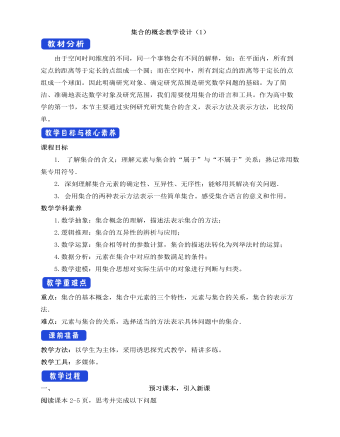
人教A版高中数学必修一集合的概念教学设计(2)
例7 用描述法表示抛物线y=x2+1上的点构成的集合.【答案】见解析 【解析】 抛物线y=x2+1上的点构成的集合可表示为:{(x,y)|y=x2+1}.变式1.[变条件,变设问]本题中点的集合若改为“{x|y=x2+1}”,则集合中的元素是什么?【答案】见解析 【解析】集合{x|y=x2+1}的代表元素是x,且x∈R,所以{x|y=x2+1}中的元素是全体实数.变式2.[变条件,变设问]本题中点的集合若改为“{y|y=x2+1}”,则集合中的元素是什么?【答案】见解析 【解析】集合{ y| y=x2+1}的代表元素是y,满足条件y=x2+1的y的取值范围是y≥1,所以{ y| y=x2+1}={ y| y≥1},所以集合中的元素是大于等于1的全体实数.解题技巧(认识集合含义的2个步骤)一看代表元素,是数集还是点集,二看元素满足什么条件即有什么公共特性。

人教A版高中数学必修一诱导公式教学设计(2)
本节主要内容是三角函数的诱导公式中的公式二至公式六,其推导过程中涉及到对称变换,充分体现对称变换思想在数学中的应用,在练习中加以应用,让学生进一步体会 的任意性;综合六组诱导公式总结出记忆诱导公式的口诀:“奇变偶不变,符号看象限”,了解从特殊到一般的数学思想的探究过程,培养学生用联系、变化的辩证唯物主义观点去分析问题的能力。诱导公式在三角函数化简、求值中具有非常重要的工具作用,要求学生能熟练的掌握和应用。课程目标1.借助单位圆,推导出正弦、余弦第二、三、四、五、六组的诱导公式,能正确运用诱导公式将任意角的三角函数化为锐角的三角函数,并解决有关三角函数求值、化简和恒等式证明问题2.通过公式的应用,了解未知到已知、复杂到简单的转化过程,培养学生的化归思想,以及信息加工能力、运算推理能力、分析问题和解决问题的能力。

